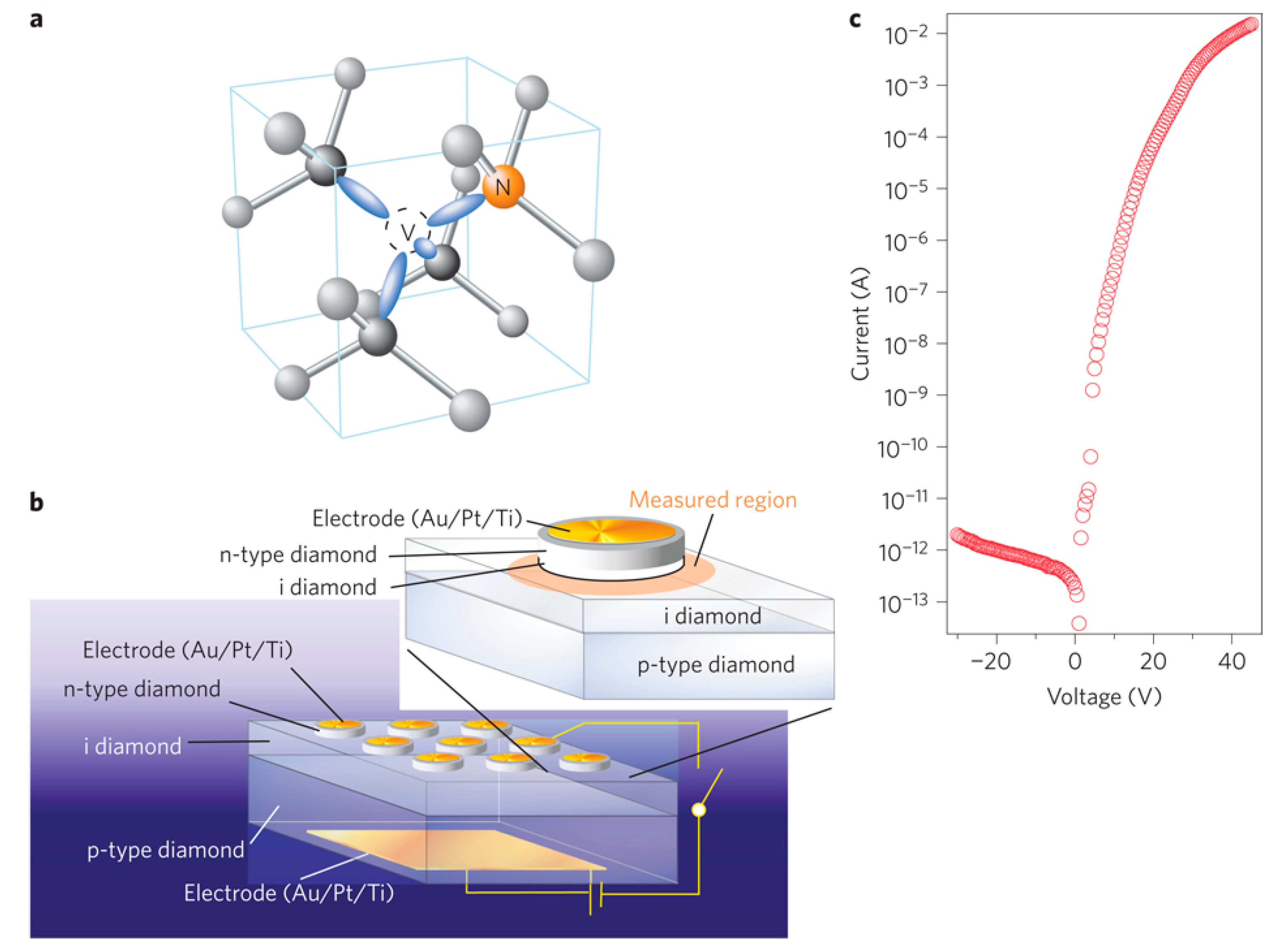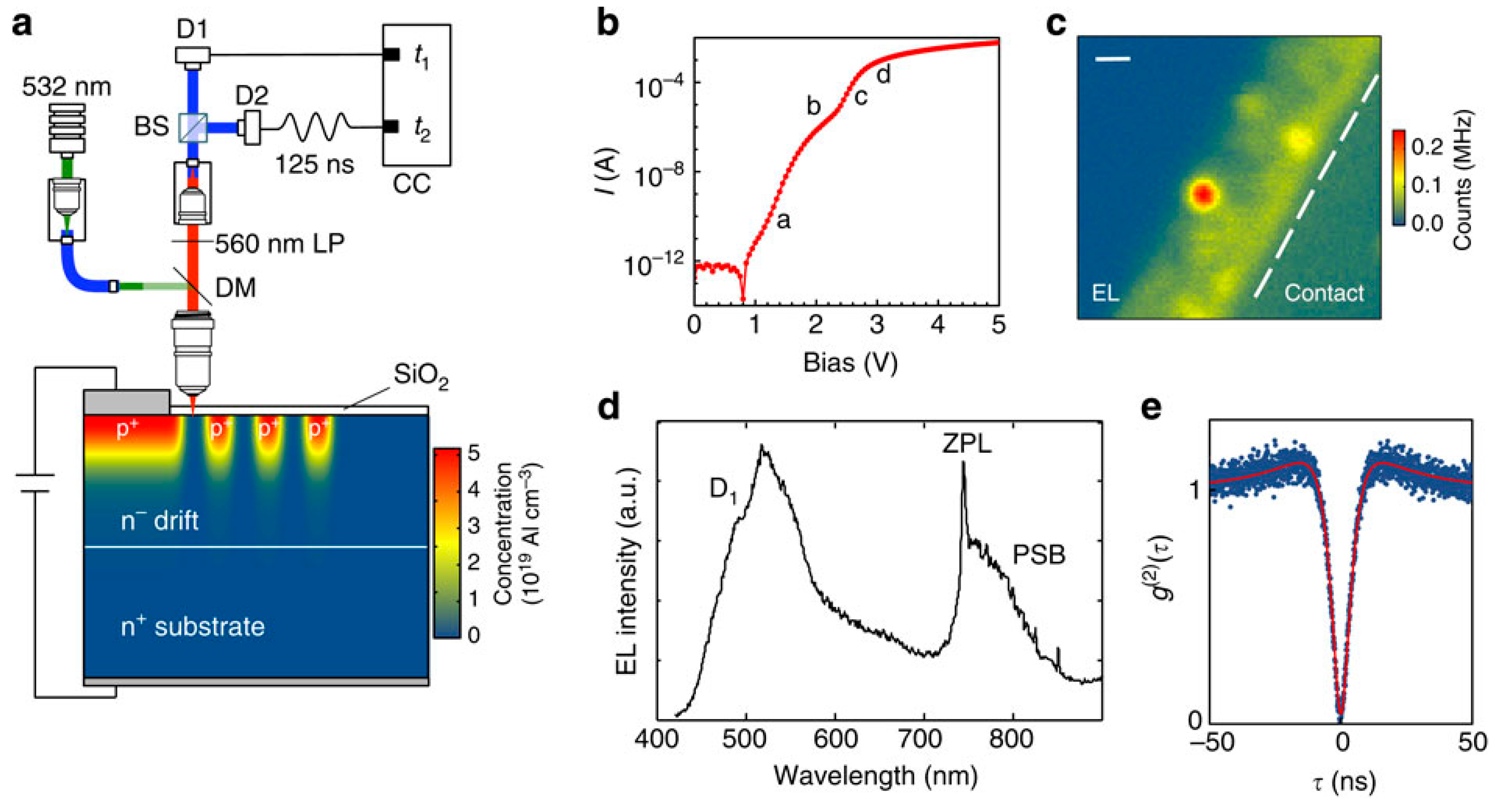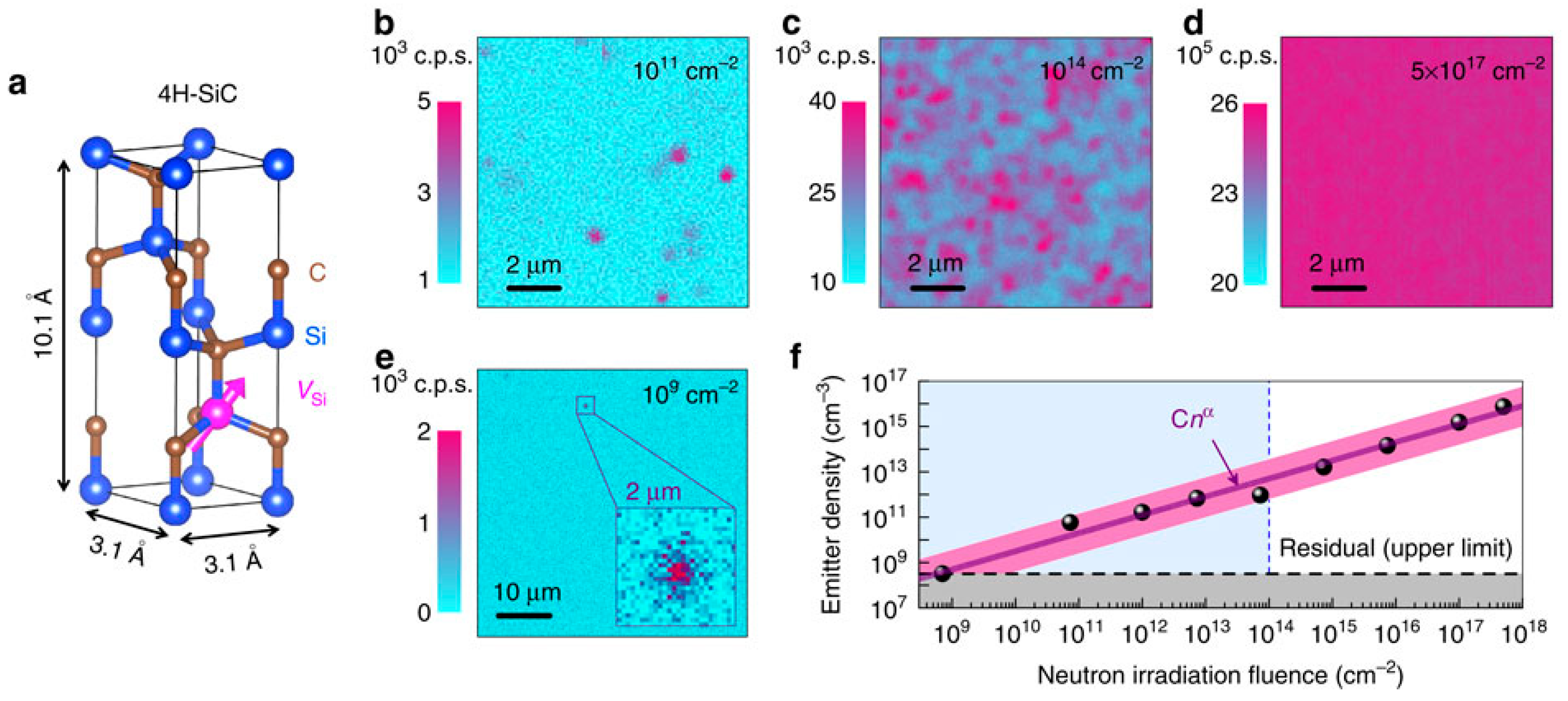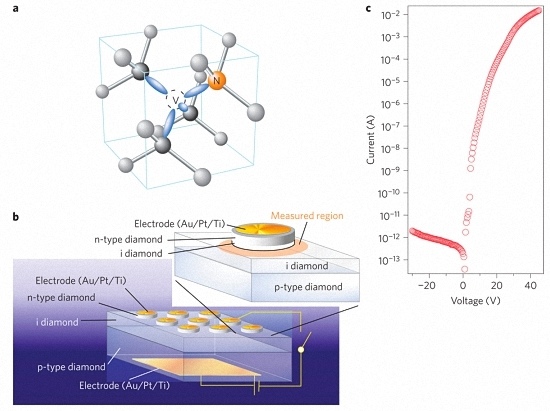Latest Advances in the Generation of Single Photons in Silicon Carbide
Abstract
:1. Introduction
2. SiC Based Single Photon Sources
3. Conclusions
Acknowledgments
Author Contributions
Conflicts of Interest
References
- Castelletto, S.; Johnson, B.C.; Boretti, A. Quantum effects in silicon carbide hold promise for novel integrated devices and sensors. Adv. Opt. Mater. 2013, 1, 609–625. [Google Scholar] [CrossRef]
- Castelletto, S.; Johnson, B.C.; Ivády, V.; Stavrias, N.; Umeda, T.; Gali, A.; Ohshima, T. A silicon carbide room-temperature single-photon source. Nat. Mater. 2014, 13, 151–156. [Google Scholar] [CrossRef] [PubMed]
- Petta, J.R.; Johnson, A.C.; Taylor, J.M.; Laird, E.A.; Yacoby, A.; Lukin, M.D.; Marcus, C.M.; Hanson, M.P.; Gossard, A.C. Coherent manipulation of coupled electron spins in semiconductor quantum dots. Science 2005, 309, 2180–2184. [Google Scholar] [CrossRef] [PubMed]
- Hofheinz, M.; Wang, H.; Ansmann, M.; Bialczak, R.C.; Lucero, E.; Neeley, M.; O’Connell, A.D.; Sank, D.; Wenner, J.; Martinis, J.M.; et al. Synthesizing arbitrary quantum states in a superconducting resonator. Nature 2009, 459, 546–549. [Google Scholar] [CrossRef] [PubMed]
- Pla, J.J.; Tan, K.Y.; Dehollain, J.P.; Lim, W.H.; Morton, J.J.L.; Jamieson, D.N.; Dzurak, A.S.; Morello, A. A single-atom electron spin qubit in silicon. Nature 2012, 489, 541–545. [Google Scholar] [CrossRef] [PubMed]
- Bounouar, S.; Elouneg-Jamroz, M.; den Hertog, M.; Morchutt, C.; Bellet-Amalric, E.; André, R.; Bougerol, C.; Genuist, Y.; Poizat, J.-P.; Tatarenko, S.; et al. Ultrafast room temperature single-photon source from nanowire-quantum dots. Nano Lett. 2012, 12, 2977–2981. [Google Scholar] [CrossRef] [PubMed]
- Holmes, M.J.; Choi, K.; Kako, S.; Arita, M.; Arakawa, Y. Room-temperature triggered single photon emission from a III-nitride site-controlled nanowire quantum dot. Nano Lett. 2014, 14, 982–986. [Google Scholar] [CrossRef] [PubMed]
- Yuan, Z.; Kardynal, B.E.; Stevenson, R.M.; Shields, A.J.; Lobo, C.J.; Cooper, K.; Beattie, N.S.; Ritchie, D.A.; Pepper, M. Electrically driven single-photon source. Science 2002, 295, 102–105. [Google Scholar] [CrossRef] [PubMed]
- Mizuochi, N.; Kato, H.; Takeuchi, D.; Ogura, M.; Okushi, H.; Nothaft, M.; Neumann, P.; Gali, A.; Jelezko, F.; Wrachtrup, J.; et al. Electrically driven single-photon source at room temperature in diamond. Nat. Photon. 2012, 6, 299–303. [Google Scholar] [CrossRef]
- Castelletto, S.; Rosa, L.; Johnson, B.C. Silicon carbide for novel quantum technology devices. In Advanced Silicon Carbide Devices and Processing; Saddow, S., La Via, F., Eds.; InTech: Rijeka, Croatia, 2015. [Google Scholar]
- Boretti, A.; Rosa, L.; Mackie, A.; Castelletto, S. Electrically driven quantum light sources. Adv. Opt. Mater. 2015, 3, 1012–1033. [Google Scholar] [CrossRef]
- Szász, K.; Ivády, V.; Abrikosov, I.A.; Janzén, E.; Bockstedte, M.; Gali, A. Spin and photophysics of carbon-antisite vacancy defect in 4H silicon carbide: A potential quantum bit. Phys. Rev. B 2015, 91, 121201. [Google Scholar] [CrossRef]
- Soltamov, V.A.; Yavkin, B.V.; Tolmachev, D.O.; Babunts, R.A.; Badalyan, A.G.; Davydov, V.Y.; Mokhov, E.N.; Proskuryakov, I.I.; Orlinskii, S.B.; Baranov, P.G. Optically addressable silicon vacancy-related spin centers in rhombic silicon carbide with high breakdown characteristics and endor evidence of their structure. Phys. Rev. Lett. 2015, 115, 247602. [Google Scholar] [CrossRef] [PubMed]
- Fuchs, F.; Soltamov, V.A.; Väth, S.; Baranov, P.G.; Mokhov, E.N.; Astakhov, G.V.; Dyakonov, V. Silicon carbide light-emitting diode as a prospective room temperature source for single photons. Sci. Rep. 2013, 3, 1637. [Google Scholar] [CrossRef] [PubMed]
- Falk, A.L.; Klimov, P.V.; Ivády, V.; Szász, K.; Christle, D.J.; Koehl, W.; Gali, A.; Awschalom, D.D. Optical polarization of nuclear spins in silicon carbide. Phys. Rev. Lett. 2015, 114, 247603. [Google Scholar] [CrossRef] [PubMed]
- Koehl, W.F.; Buckley, B.B.; Heremans, F.J.; Calusine, G.; Awschalom, D.D. Room temperature coherent control of defect spin qubits in silicon carbide. Nature 2011, 479, 84–87. [Google Scholar] [CrossRef] [PubMed]
- Zwier, O.V.; O’Shea, D.; Onur, A.R.; van der Wal, C.H. All-optical coherent population trapping with defect spin ensembles in silicon carbide. Sci. Rep. 2015, 5, 10931. [Google Scholar] [CrossRef] [PubMed]
- Christle, D.J.; Falk, A.L.; Andrich, P.; Klimov, P.V.; Hassan, J.U.; Son, N.T.; Janzén, E.; Ohshima, T.; Awschalom, D.D. Isolated electron spins in silicon carbide with millisecond coherence times. Nat. Mater. 2015, 14, 160–163. [Google Scholar] [CrossRef] [PubMed]
- Widmann, M.; Lee, S.-Y.; Rendler, T.; Son, N.T.; Fedder, H.; Paik, S.; Yang, L.-P.; Zhao, N.; Yang, S.; Booker, I.; et al. Coherent control of single spins in silicon carbide at room temperature. Nat. Mater. 2015, 14, 164–168. [Google Scholar] [CrossRef] [PubMed]
- Muzha, A.; Fuchs, F.; Tarakina, N.V.; Simin, D.; Trupke, M.; Soltamov, V.A.; Mokhov, E.N.; Baranov, P.G.; Dyakonov, V.; Krueger, A.; et al. Room-temperature near-infrared silicon carbide nanocrystalline emitters based on optically aligned spin defects. Appl. Phys. Lett. 2014, 105, 243112. [Google Scholar] [CrossRef]
- Lohrmann, A.; Iwamoto, N.; Bodrog, Z.; Castelletto, S.; Ohshima, T.; Karle, T.J.; Gali, A.; Prawer, S.; McCallum, J.C.; Johnson, B.C. Single-photon emitting diode in silicon carbide. Nat. Commun. 2015, 6, 7783. [Google Scholar] [CrossRef] [PubMed]
- Fuchs, F.; Stender, B.; Trupke, M.; Simin, D.; Pflaum, J.; Dyakonov, V.; Astakhov, G.V. Engineering near-infrared single-photon emitters with optically active spins in ultrapure silicon carbide. Nat. Commun. 2015, 6, 7578. [Google Scholar] [CrossRef] [PubMed]
- Carter, S.G.; Soykal, Ö.O.; Dev, P.; Economou, S.E.; Glaser, E.R. Spin coherence and echo modulation of the silicon vacancy in 4H-SiC at room temperature. Phys. Rev. B 2015, 92, 161202. [Google Scholar] [CrossRef]
- Astakhov, G.V.; Kraus, H.; Soltamov, V.A.; Fuchs, F.; Simin, D.; Sperlich, A.; Baranov, P.G.; Dyakonov, V. Magnetic field and temperature sensing with atomic-scale spin defects in silicon carbide. Sci. Rep. 2014, 4, 5303. [Google Scholar] [CrossRef]
- Klimov, P.V.; Falk, A.L.; Buckley, B.B.; Awschalom, D.D. Electrically driven spin resonance in silicon carbide color centers. Phys. Rev. Lett. 2014, 112, 087601. [Google Scholar] [CrossRef]



© 2016 by the authors; licensee MDPI, Basel, Switzerland. This article is an open access article distributed under the terms and conditions of the Creative Commons Attribution (CC-BY) license (http://creativecommons.org/licenses/by/4.0/).
Share and Cite
Boretti, A.; Rosa, L. Latest Advances in the Generation of Single Photons in Silicon Carbide. Technologies 2016, 4, 16. https://doi.org/10.3390/technologies4020016
Boretti A, Rosa L. Latest Advances in the Generation of Single Photons in Silicon Carbide. Technologies. 2016; 4(2):16. https://doi.org/10.3390/technologies4020016
Chicago/Turabian StyleBoretti, Albert, and Lorenzo Rosa. 2016. "Latest Advances in the Generation of Single Photons in Silicon Carbide" Technologies 4, no. 2: 16. https://doi.org/10.3390/technologies4020016






